Transient Effects in Creep of Sanicro 25 Austenitic Steel and Their Modelling
Abstract
1. Introduction
2. Experimental Material and Procedure
2.1. Material
2.2. Creep Tests
3. Results
3.1. Creep Curves
3.2. Creep Rates
4. Model
4.1. Creep Rate Description
4.2. Model Results
4.3. Discussion
5. Conclusions
Author Contributions
Funding
Acknowledgments
Conflicts of Interest
Abbreviations
| FEM | Finite Element Method |
References
- Chai, G.; Bostrom, M.; Olaison, M.; Forsberg, U. Creep and LCF Behaviors of Newly Developed Advanced Heat Resistant Austenitic Stainless Steel for A-USC. Procedia Eng. 2013, 55, 232–239. [Google Scholar] [CrossRef]
- Polak, J.; Petras, R.; Heczko, M.; Kruml, T.; Chai, G. Evolution of the cyclic plastic response of Sanicro 25 steel cycled at ambient and elevated temperatures. Int. J. Fatigue 2016, 83, 75–83. [Google Scholar] [CrossRef]
- Petras, R.; Skorik, V.; Polak, J. Thermomechanical fatigue and damage mechanisms in Sanicro 25 steel. Mater. Sci. Eng. A 2016, 650, 52–62. [Google Scholar] [CrossRef]
- Chai, G.; Forsberg, U. Sanicro 25: An advanced high-strength, heat-resistant austenitic stainless steel. In Materials for Ultra-Supercritical and Advanced Ultra-Supercritical Power Plants; DiGianfrancesco, A., Ed.; Number 104 in Series in Energy; Woodhead Publishing: Cambridge, UK, 2017; pp. 391–421. [Google Scholar]
- Kloc, L. Critical View on the Creep Modelling Procedures. Acta Phys. Pol. A 2015, 128, 540–542. [Google Scholar] [CrossRef]
- Sritharan, T.; Jones, H. Creep of Type-316 Stainless-steel at Low Stresses. Met. Sci. 1989, 15, 365–368. [Google Scholar] [CrossRef]
- Mishra, R.S.; Jones, H.; Greenwood, G.W. Creep of a low carbon steel at low stresses and intermediate temperatures. Acta Metall. Mater. 1990, 38, 461–468. [Google Scholar] [CrossRef]
- Kloc, L.; Skienicka, V.; Ventruba, J. Comparison of low stress creep properties of ferritic and austenitic creep resistant steels. Mater. Sci. Eng. A 2001, 319, 774–778. [Google Scholar] [CrossRef]
- Kloc, L.; Dymáček, P.; Sklenička, V. High temperature creep of Sanicro 25 austenitic steel at low stresses. Mater. Sci. Eng. A 2018, 722, 88–92. [Google Scholar] [CrossRef]
- Kloc, L.; Sklenička, V.; Dymáček, P.; Plešek, J. New creep constitutive equation for finite element modelling including transient effects. Mech. Mater. 2018, 119, 49–55. [Google Scholar] [CrossRef]
- Heczko, M.; Polak, J.; Kruml, T. Microstructure and dislocation arrangements in Sanicro 25 steel fatigued at ambient and elevated temperatures. Mater. Sci. Eng. A 2017, 680, 168–181. [Google Scholar] [CrossRef]
- Polak, J.; Petras, R.; Heczko, M.; Kubena, I.; Kruml, T.; Chai, G.C. Low cycle fatigue behavior of Sanicro 25 steel at room and at elevated temperature. Mater. Sci. Eng. A 2014, 615, 175–182. [Google Scholar] [CrossRef]
- Zhou, R.Y.; Zhu, L.H.; Liu, Y.Y.; Lu, Z.R.; Chen, L.; Ma, X. Microstructural evolution and the effect on hardness of Sanicro 25 welded joint base metal after creep at 973 K. J. Mater. Sci. 2017, 52, 6161–6172. [Google Scholar] [CrossRef]
- Calmunger, M.; Chai, G.C.; Eriksson, R.; Johansson, S.; Moverare, J.J. Characterization of Austenitic Stainless Steels Deformed at Elevated Temperature. Metall. Mater. Trans. A-Phys. Metall. Mater. Sci. 2017, 48A, 4525–4538. [Google Scholar] [CrossRef]
- Kloc, L.; Marecek, P. Measurement of Very Low Creep Strains: A Review. J. Test. Eval. 2009, 37, 53–58. [Google Scholar]
- Kloc, L.; Sklenicka, V. Confirmation of low stress creep regime in 9% chromium steel by stress change creep experiments. Mater. Sci. Eng. A 2004, 387, 633–638. [Google Scholar] [CrossRef]
- Li, J. A Dislocation Mechanism of Transient Creep. Acta Metall. 1963, 11, 1269–1270. [Google Scholar] [CrossRef]
- Dymacek, P.; Dobes, F.; Kloc, L. Small Punch Testing of Sanicro 25 Steel and its Correlation with Uniaxial Tests. Key Eng. Mater. 2017, 734, 70–76. [Google Scholar] [CrossRef]
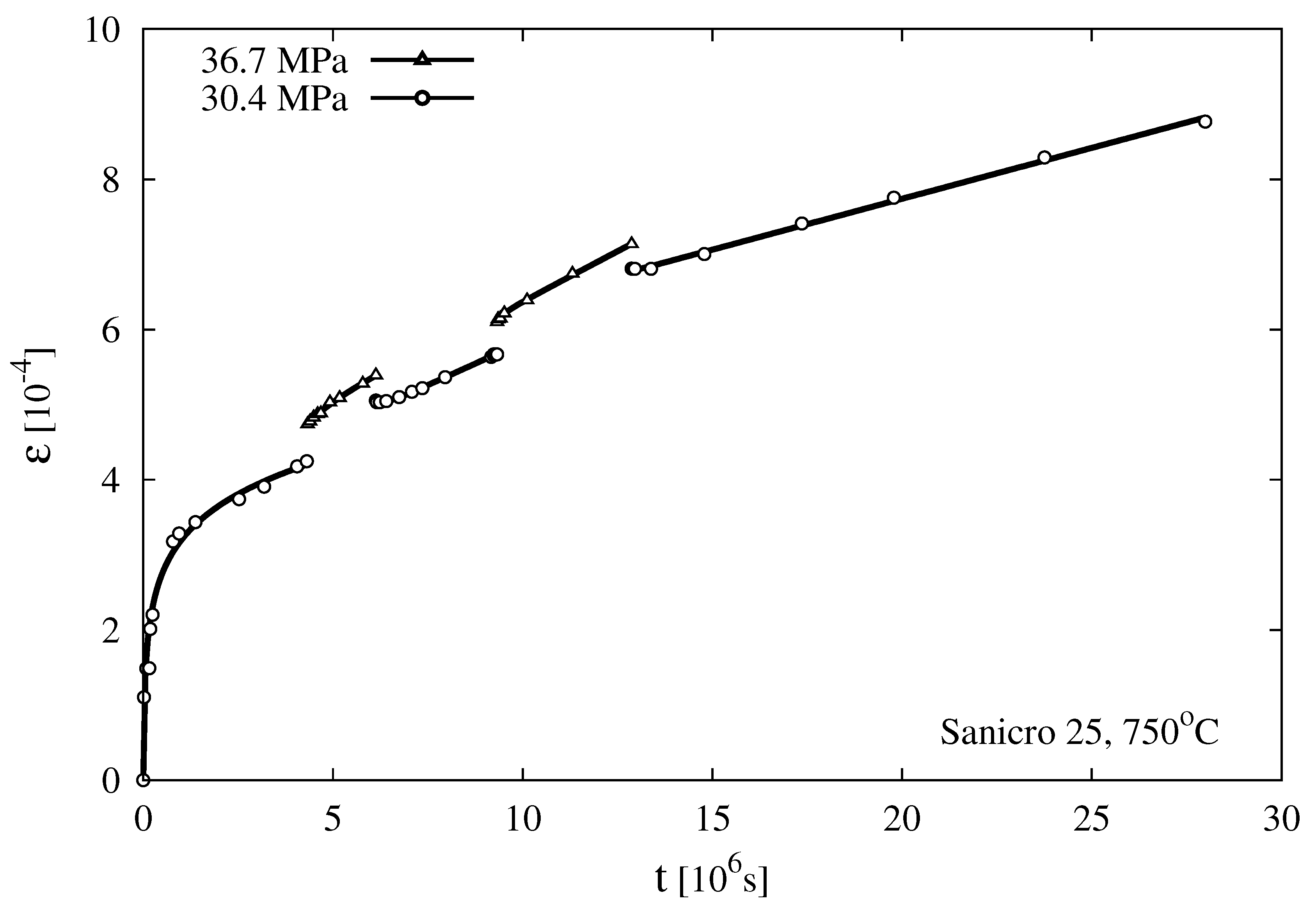
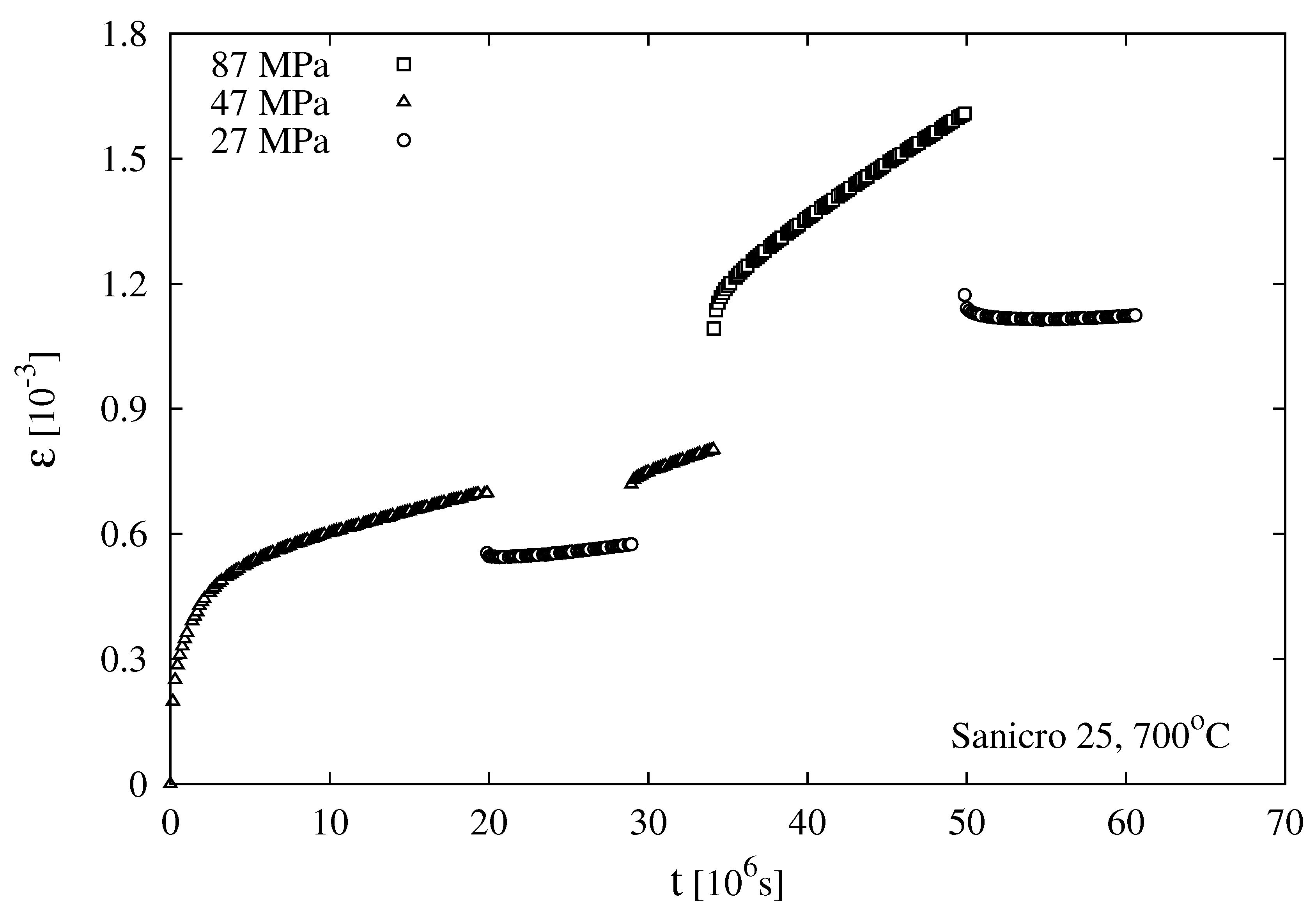
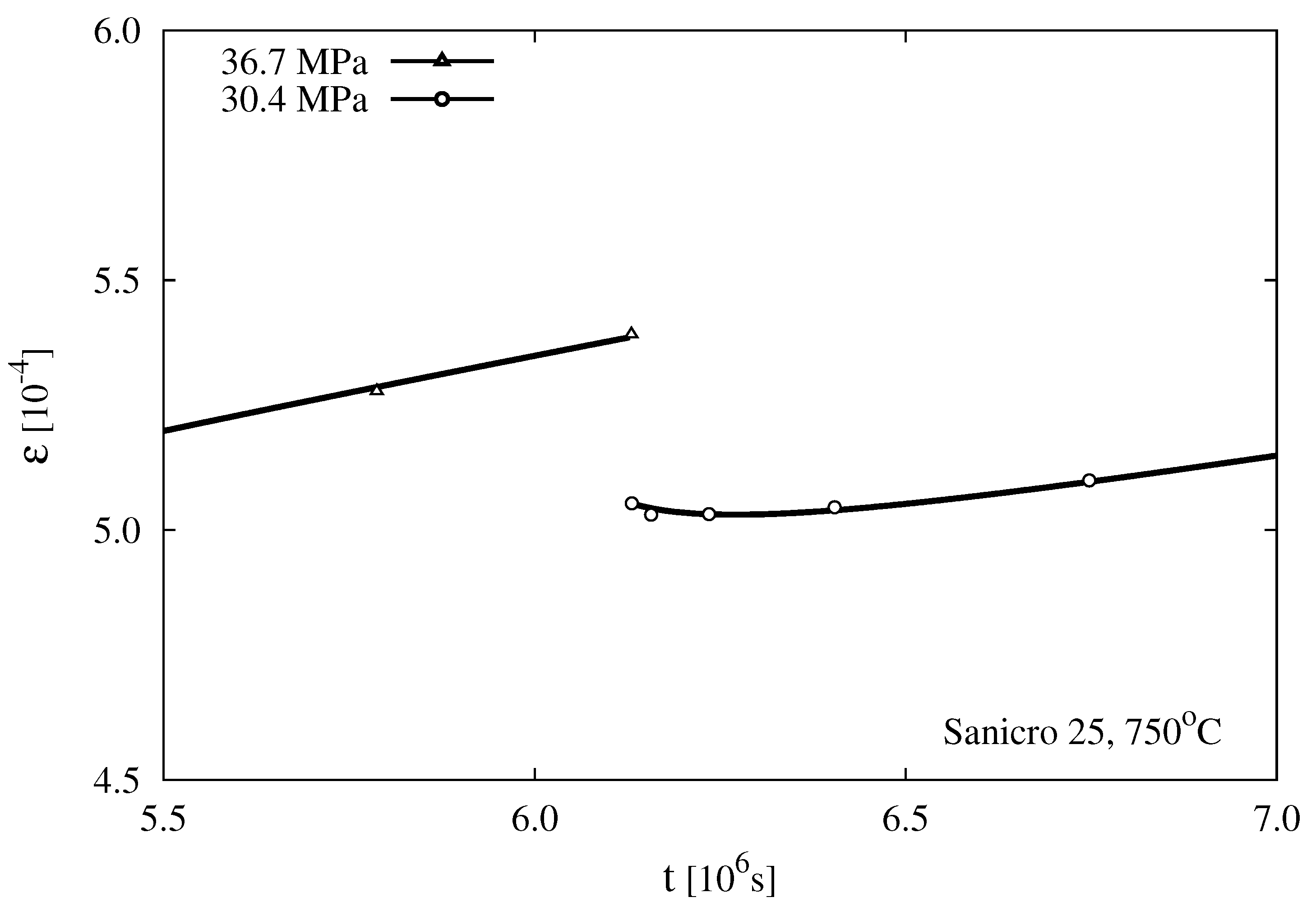
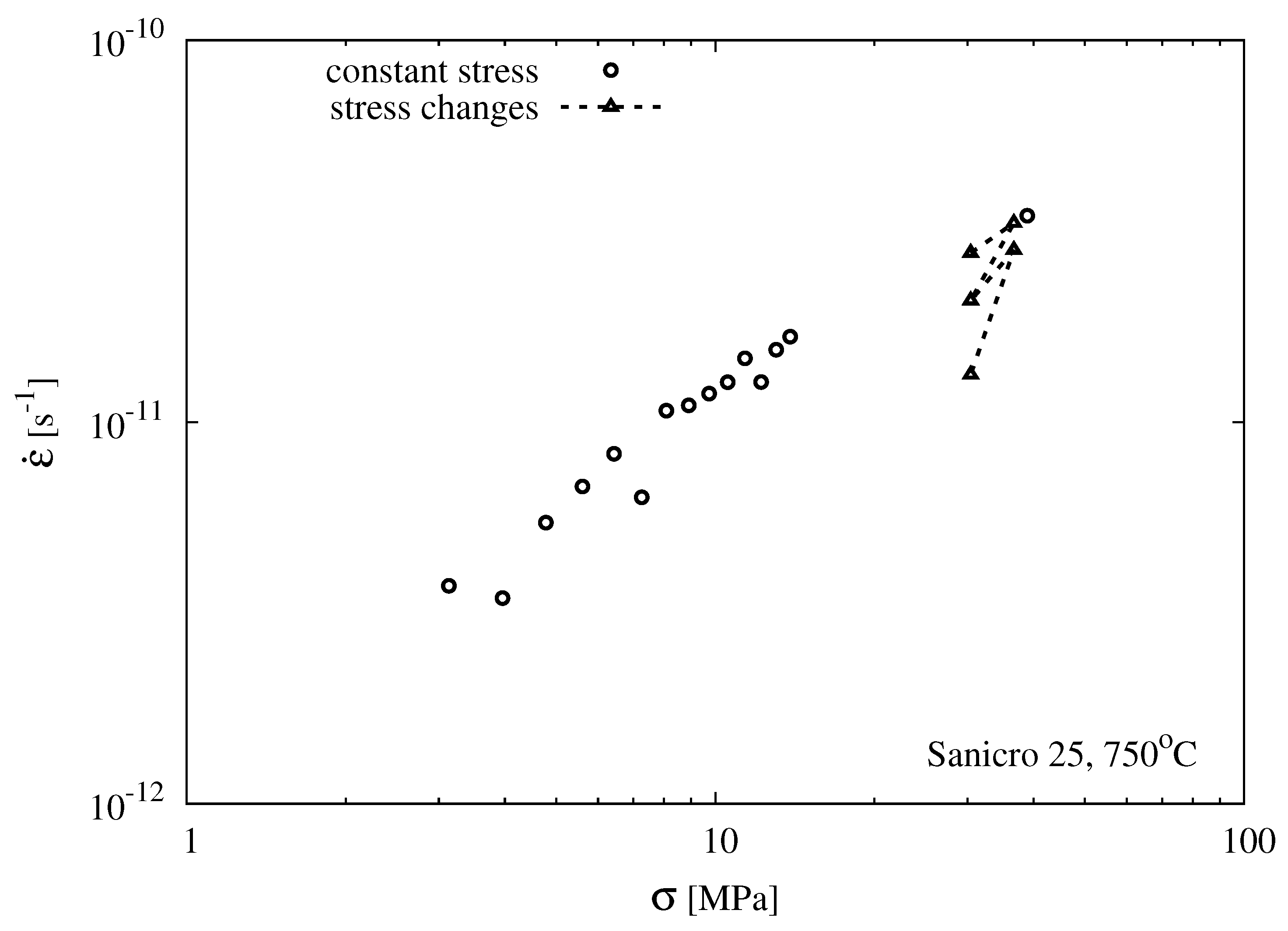
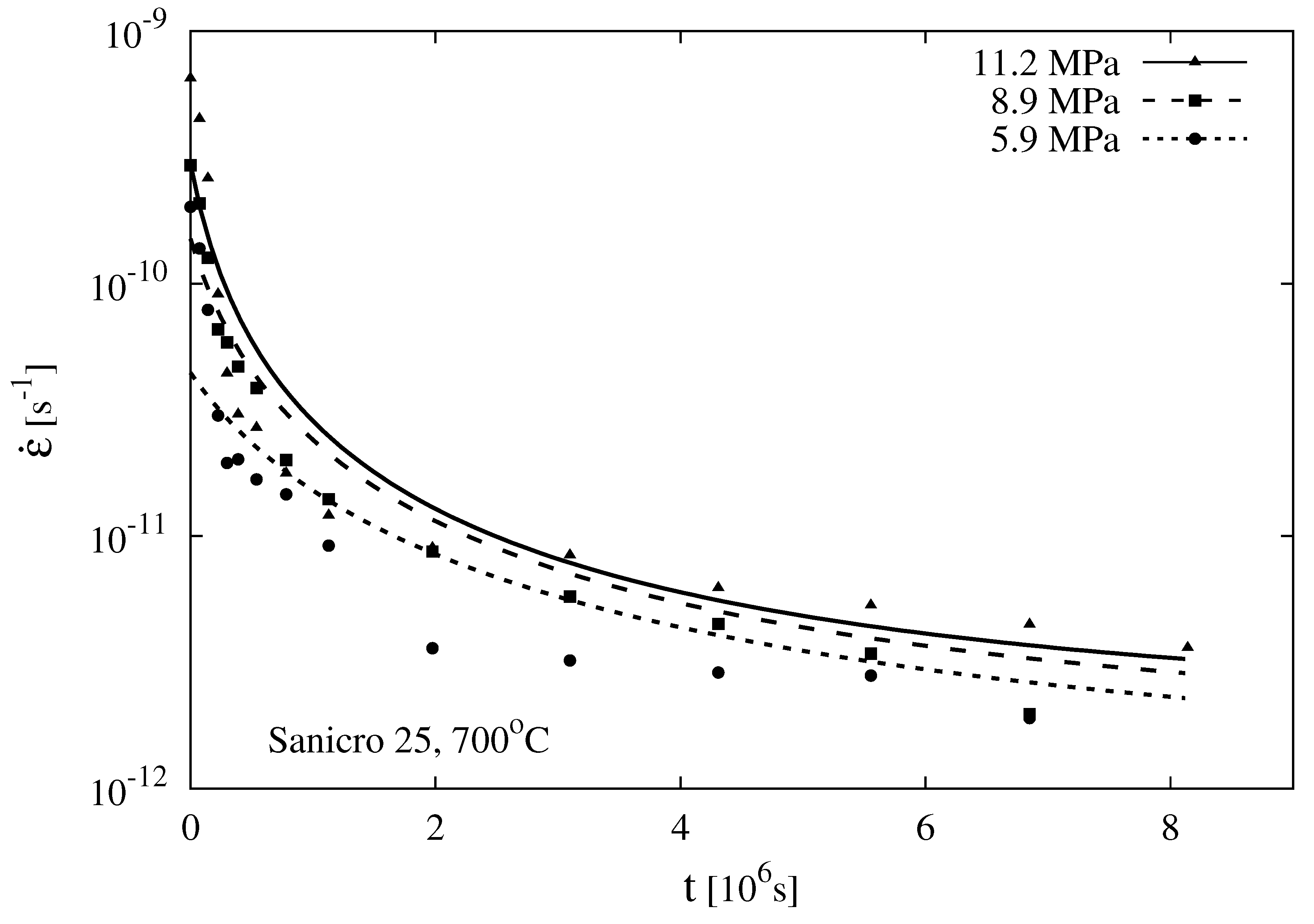
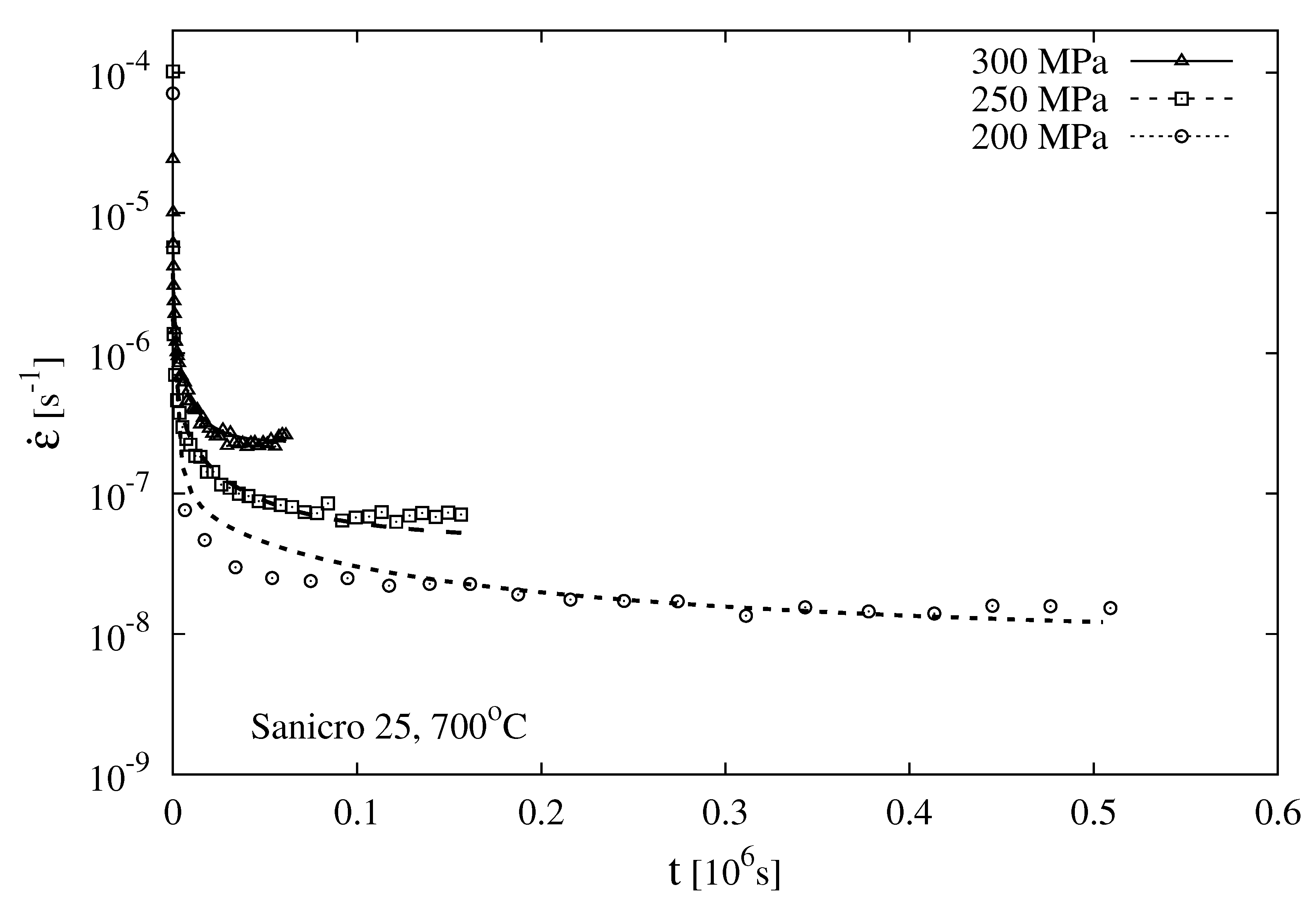
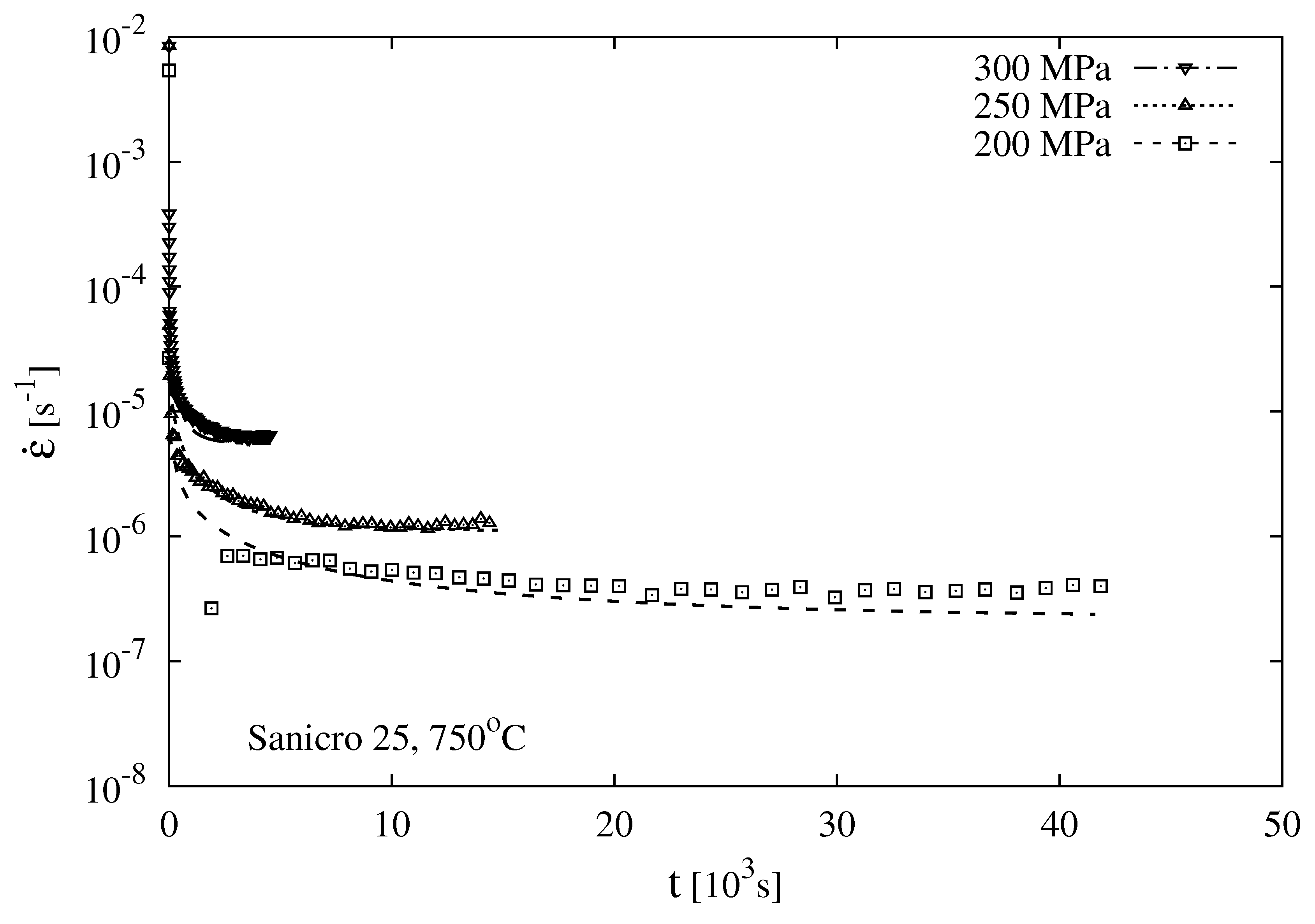
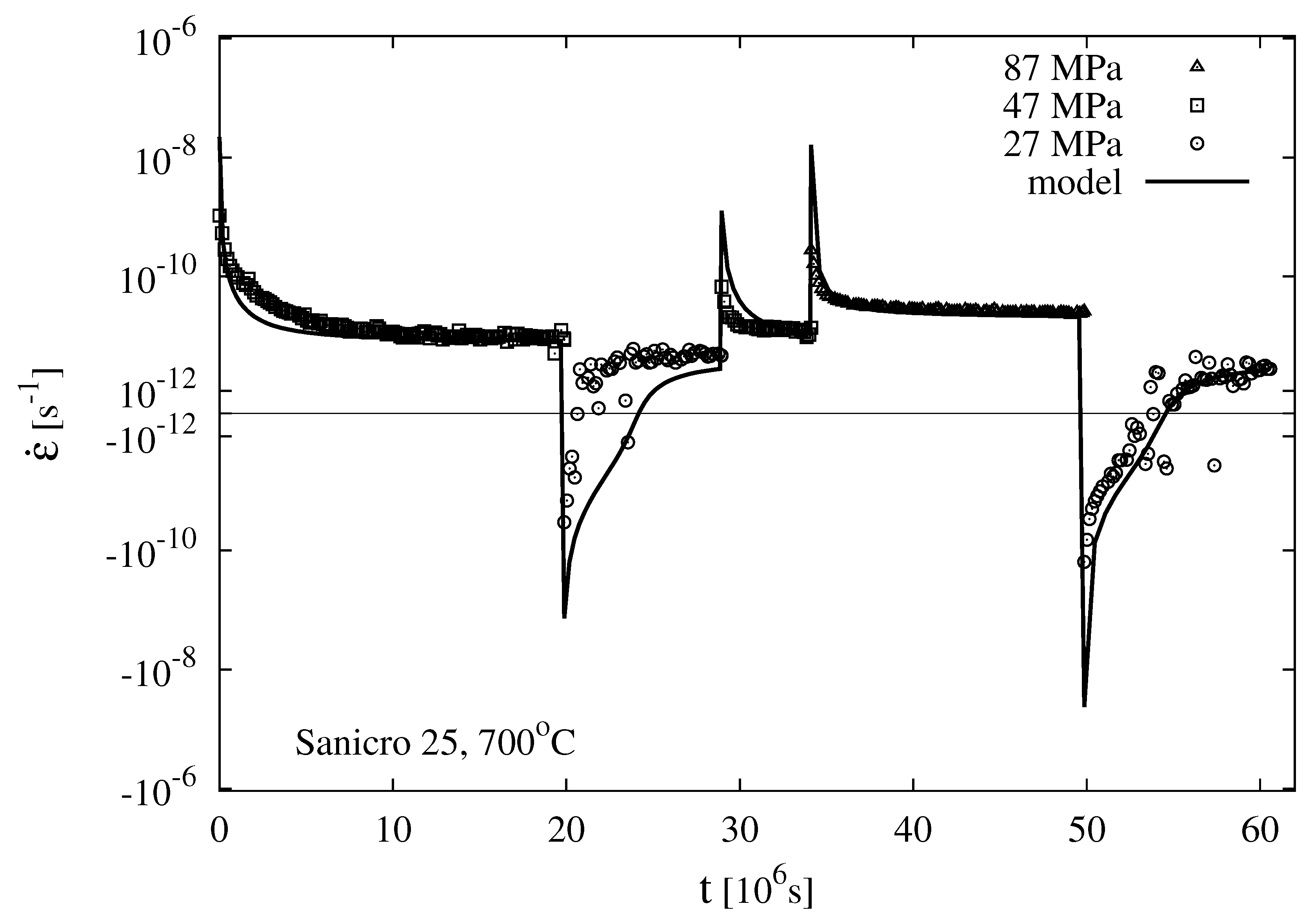
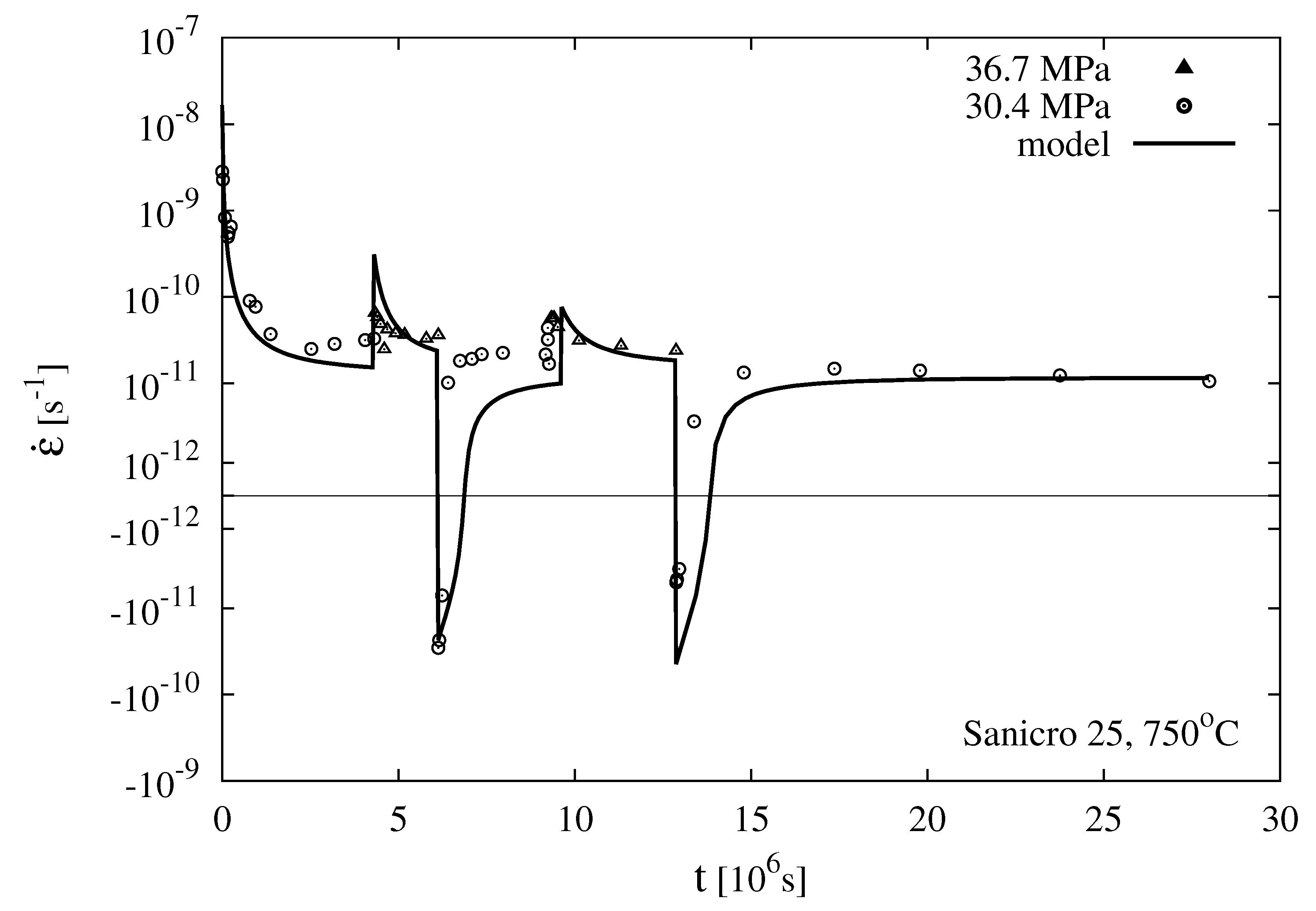
| C | Si | Mn | Cr | Ni | W | Co | Cu | Nb | N | Fe |
|---|---|---|---|---|---|---|---|---|---|---|
| 0.1 | 0.2 | 0.5 | 22.5 | 25.0 | 3.6 | 1.5 | 3.0 | 0.5 | 0.23 | Bal. |
| Parameter | Value | Unit | |
|---|---|---|---|
| 130 | MPa | ||
| 3.0 | MPa | @700 C | |
| 1.0 | MPa | @750 C | |
| 8.0 | |||
| b | s | ||
| p | 0.03 | MPa | |
| 525 | kJ/mol | ||
| 171 | kJ/mol | ||
| g | 700 | s | |
| E | MPa | ||
| k | 0.65 | ||
| c |
© 2019 by the authors. Licensee MDPI, Basel, Switzerland. This article is an open access article distributed under the terms and conditions of the Creative Commons Attribution (CC BY) license (http://creativecommons.org/licenses/by/4.0/).
Share and Cite
Kloc, L.; Sklenička, V.; Dymáček, P. Transient Effects in Creep of Sanicro 25 Austenitic Steel and Their Modelling. Metals 2019, 9, 245. https://doi.org/10.3390/met9020245
Kloc L, Sklenička V, Dymáček P. Transient Effects in Creep of Sanicro 25 Austenitic Steel and Their Modelling. Metals. 2019; 9(2):245. https://doi.org/10.3390/met9020245
Chicago/Turabian StyleKloc, Luboš, Václav Sklenička, and Petr Dymáček. 2019. "Transient Effects in Creep of Sanicro 25 Austenitic Steel and Their Modelling" Metals 9, no. 2: 245. https://doi.org/10.3390/met9020245
APA StyleKloc, L., Sklenička, V., & Dymáček, P. (2019). Transient Effects in Creep of Sanicro 25 Austenitic Steel and Their Modelling. Metals, 9(2), 245. https://doi.org/10.3390/met9020245




